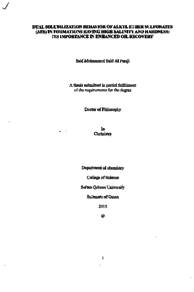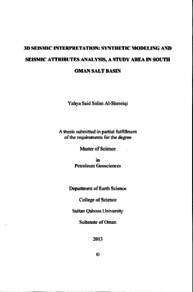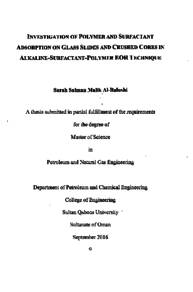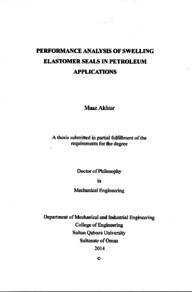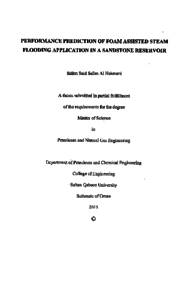Document
Dual solubilization behavior of alkyl ether sulfonates (AES)in formations having high salinity and hardness
Other titles
its importance in enhanced oil recovery
Publisher
Sultan Qaboos University
Gregorian
2015
Language
English
English abstract
The effect of temperature on the compatibility of a series of alkyl ether sulfonates AES (AE;) with synthetic brine having high salinity and hardness (brine B1) has been investigated. Three surfactants were used in this study, iC17EOXS(C17E0x (x = 7 and 10) and nC17E010S(1C17E010) along with their analogous nonionic surfactants iC17EOX (X = 7 and 10) and nC17E010. In addition, nine nonionic alkyl ether AE surfactants (100% active) were also included in this investigation, namely iCgEOX (x = 6, 10, 14), iC10EOX (x = 10, 13, 18) and iC13EOx (x = 10, 13, 18). Depending on their molecular structures, AES (AE;) exhibited concentration-dependent clear point and cloud point behavior in synthetic brine. The cloud point was associated to the non sulfonated component (AE;) whereas the clear point was attributed to the sulfonated one (AES;). Interestingly, the cloud point of the nonionic component was significantly increased in the presence of the anionic component compared to the cloud point of the same AE surfactant alone (100% active). In addition, branching has a strong effect on the clear point of the anionic AES component as reflected by a clear point below room temperature in iC17E010S(iC17E010) micelles compared to a clear point above the boiling point of water in nC17E010S(iC17E010 micelles. Likewise, increasing the degree of ethoxylation by three ethylene oxide (EO) units results in a significant decrease in the clear point from above 100 °C in iC17EOS(iC17E07) to below room temperature in iC17E010S(iCj7E010). These observations were attributed to the effect of surfactant structure on its solubilization in water.
The addition of an extrinsic AE (100% active) to iC17E02S(iC17E07), iC17E010S(iC17E010), and nC17E07S(nC17E07) resulted in a significant enhancement of their compatibility with brine. Clear and stable surfactant mixtures were observed in a wide range of mixed micelle composition and temperature. Particularly, our results showed that i) the clear point of the anionic component AES is significantly decreased from above the boiling point of water to below room temperature, ii) the cloud point in mixed micelles is strongly influenced by the addition of the extrinsic AE surfactant, and iii) both above effects are correlated
The variation of the cloud point in iC17E07S(C17E0YiC9E014 system with mixed micelle composition revealed three distinct modes of variation i) region I: an increase from 68 °C (cloud point in C9E014 single micelles) to 73 °C (Xan= 0. 220), ii) region II: a decrease from 73 °C (Xan = 0.220) to 67°C (Xan = 0.379), and iii) region III: cloud point below room temperature (Xan = 0.492 - 0.836). This behavior suggest that dehydration of EO groups via intramolecular ion (SO3 )-dipole (0-CH2) attractive interactions (factor promoting cloud point depression) may also compete with electrostatic repulsion between mixed micelles (factor promoting cloud point increase).
Due to the presence of an intrinsic nonionic AEi component in AES(AE) surfactant, we described the nonionic mixture iC17E07/iC9E014 by an equivalent single nonionic alkyl ether surfactant characterized by its lipophilic to hydrophilic ratio Rih = . Interestingly, a clear correlation between the variation of the ratio Rih with Xan and the variation of the cloud point with Xan was observed as reflected by three distinct modes of variation occurring within a range of mixed micelle compositions similar to that observed with the corresponding variation of the cloud point with Xan
This suggest that the ratio Rin plays a dominant role in the variation of the cloud point
with Xan in iC17EO S(iC17EO)/iC9E014 system, along with other factors such as mixed micelle charge and ion-dipole interactions.
The effect of mixed micelle composition on mixed micellization properties (CMC surface area occupied per surfactant molecule a.) in iC17E07S(iC17E07)/C9E014/brine B1 showed an evident correlation between the variation of the CMC and a, in one hand and the variation of the cloud point with Xan in the other hand. Thus, mixed micellar structure (size, shape, packing of the hydrophilic groups at the interface,..) appears to play also a significant role in the variation of the cloud point with Xan.
The effect of salinity on the cloud point of iC17E07/iCEO14 mixture in iC17E07S(C17E07)/iC,E014 system revealed that at any given Xan, the cloud point monotonically decreases with salinity. We attributed this cloud point depression to the swamping of original charge distribution and shielding of repulsion between micelles with the addition of electrolytes. However, the variation in the cloud point with mixed micelle composition is independent of the total salinity and hardness and is only determined by the mixed micelle composition as reflected by the fact that the optimum cloud point value occurs at Xan = 0.220, whatever the brine composition and concentration.
The effect of hardness (Ca2+ and Mg2+) and NaCl on the cloud point of iC1E07)/iC,E014 and iC17E07/i<10E014 mixtures in iCj7EO S(iC1E07)/iC9E014 and iC17EO S(iC17E07)/iC1E014 mixed micelles was also investigated in brine 1 (BI), softened brine B1 (removal of Ca** and Mg* from brine B1), and desalted brine B1 (removal of NaCl from brine B1). The trend in the variation of the cloud point verşus total salinity is again independent of the salinity and increases in the order desalted brine > softened brine > synthetic brine i,e, in the order of decreasing electrolyte (Na*, Cat, Mg) concentration: 2.50 M (B1)> 2.1 M (softened water) > desalted water (0.41 M). This was attributed, to some extent, to the fact that the nature of charge distribution at the mixed micelle-water interface is mainly determined by the binding counterions Na*, Mg2+, and Ca2.
Finally, although iC1E02S(iC17E07) is not compatible with Lekhweir reservoir conditions (brine B1 and T = 70 °C), clear and stable iC17E07S(iC17E07)/iC9E014 surfactant mixtures were formulated for oil-in-water microemulsion flood in Lekhweir reservoir (oil solubilization parameter 5 = 50 at 0.025 wt% total surfactant concentration and IFT = 3.4 x 102mNm').
Member of
Resource URL
Arabic abstract
تعتبر سلفونات الألكيل ايثر (AES) أحد أنواع معاملات التنشيط السطحي (surfactants) المستخدمة في تعزيز انتاج النفط (EOR) من حقول النفط التي تتميز بارتفاع درجات الحرارة وكميات عالية من الملوحة. إلا أن في البداية تم اعتبار هذه المعاملات مركبات اليونية تحمل الصفات الفيزيائية والكيميائية للمركبات الأنيونية فقط، ولكن في الحقيقة أن عملية تحويل مركبات الألكيل ايثر (AE) إلى سلفونات ليست عملية تامة وإنما تتبقى نسبة من الأكيل الإيثر لا تتحول الى سلفونات حيث تظل موجودة في المزيج. لذلك لا بد من الوضع في الاعتبار خواص المركبات الغير ايونية المتمثلة في الألكيل ايثر (AE) عند استخدام هذه المواد في تعزيز انتاج النفط حيث قمنا في هذه الدراسة بالتحقق من ذوبانية وملائمة هذه المواد في المحاليل ذات درجات الحرارة العالية والملوحة المرتفعة جدا مثل تلك الموجودة في حقول الخوير النفط، حيث قمنا بتحديد درجات الحرارة التي تتحول عندها المحاليل المتعكرة لمركبات سلفونات الألكيل ايثر(AES) إلى محاليل شفافة واضحة يمكن استخدامها في تعزيز انتاج النفط (clear point) وكذلك درجات الحرارة التي تتحول عندها محاليل مركبات الألكيل ايثر الغير أيونية الشفافة إلى محاليل متعكرة (cloud point). حيث تمت دراسة تأثير درجات الحرارة على محاليل مجموعة من مركبات (AE) التي تحمل الصيغ الجزيئية ,10 = EO, X = 9, 13, 14; iCi0EO, X = 7 , 10, 14) ; and iCi3EO XوiC) (18 ,13) حيث وجدت جميعها شفافة إلا أنها تتعكر عند ارتفاع درجات الحرارة في درجات اقل من درجة حرارة حقل الخوير لذا لا يمكن استخدامها في عمليات (EOR) كما تمت دراسة تاثير درجات الحرارة على محاليل (AES) التي تحمل الصيغ الجزيئية (iCiEOS (iCiEO1 ) , iCiEOoS (iCiEO10) , and (nCiEO, S (nCjE0) وهذه المركبات في الحقيقة هي عبارة عن مزيج يتكون من % 0. 15 من الجزء الغير ايوني (AE) و % 0. 85 من الجزء الانيوني (AES) . حيث وجدنا أن محلول المركب ( iCiEO, SiCiEO متعكرا عند درجة حرارة الغرفة ويظل كذلك حتى عند درجة الغليان الماء وهذا يدل على أن (clear point) لهذا المركب اعلى من درجة الغليان بينما كان محلول المركب (ور iCiEO, SiCEO شفافا واضحا مما يدل على أن (clear point) لهذا المركب اقل من درجة حرارة الغرفة إلا أنه تحول الى محلول عكر عند ارتفاع درجة الحرارة. أما المركب الثالث ( nCEOS (nCjE0) فقد أظهر خاصية ثنائية بكل وضوح حيث كان عكر وبالتسخين تحول الا محلول شفاف وهذا يرجع إلى clear point للجزء الأيوني في المزيج (nCEOS) ثم تحول بالتسخين الى محلول عكر عند درجة حرارة معينة وهذا يدل على (cloud point) للجزء الغير ایوني ( ,nCiEO) في المزيج. ولكي نرفع من ملائمة هذه المركبات مع ظروف حقل النفط من درجات الحرارة المرتفعة والملوحة العالية قمنا بخلط مركبات (AES) مع مركبات (AE) بنسب مختلفة وحصلنا على درجات عالية من ملائمة هذه المركبات مع تلك الظروف من درجات الحرارة والملوحة كما قمنا بدراسة تاثير الملوحة على ملائمة هذه المركبات للملوحة العالية ووجدنا ان (cloud point) لهذه المركبات تقل بارتفاع تركيز الملوحة. وعند فحص تاثير الملوحة على منحنى درجات (cloud point) وجدنا أنه لا يوجد تأثير على سلوك المنحنى حيث يرتفع قليلا ثم ينخفض مما يدل على ان الملوحة لا تؤثر على اتجاه المنحنى وانما على ارتفاع وانخفاض درجات (cloud point) فقط. وفي دراسة تأثير حجم وشكل (micelle) الذي تكونه هذه المركبات على منحنی درجات (cloud point) وجدنا أنه توجد علاقة بين المنحني الذي تسلكه هذه الدرجات مع شكل وحجم (micelle) حيث يوجد تغير في قيمة التركيز الذي تبدا معه هذه المعاملات بتكوين تجمعات التي يطلق عليها (micelle) في نفس المنطقة التي يحدث معها تغير في سلوك (cloud point). ومن ناحية اخرى من خلال دراسة امتزاج النفط مع محاليل هذه المواد وجدنا انه يمكن امتزاج كمية كبيره من النفط بفعل هذه المواد عند استخدام مزيج معين من هذه المركبات. و أوضحت الدراسية ايضا ان هذه المواد يمكن أن تقلل من التوتر بين الأسطح (interfacial tension) إلى قيم صغيره جدا يمكن عندها استخدام هذه المواد في تعزيز انتاج النفط .
Category
Theses and Dissertations

